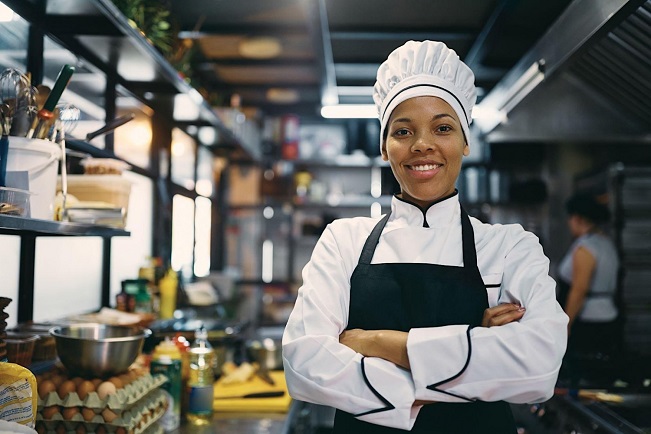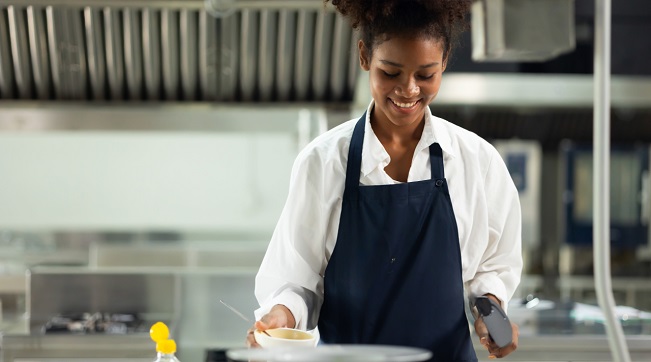Picture a world of constant heat, sizzling pans, and the frenetic energy of a well-oiled machine. This is the domain of the professional kitchen, a demanding environment where precision and performance are essential. Every element, from the ingredients to the equipment, plays a vital role. But what about the chefs themselves? In this whirlwind of activity, functional and comfortable chef wear becomes a matter of style, safety, and peak performance.
Essential Layers

Durable Chef Coats
The heart of any functional chef’s clothing lies in its ability to withstand the heat (literally) of the kitchen. Your chef coat is your culinary armour, protecting you from spills, splatters, and the inevitable burst of oven heat. Look for coats made from heavyweight fabrics like cotton or a cotton blend that offer excellent heat resistance while remaining breathable. Easy cleaning is necessary, so opt for materials that can withstand frequent washing and staining resistance.
When it comes to style, two main options dominate the chef coat scene: double-breasted and single-breasted. Double-breasted coats offer a classic, professional chef uniform look and provide additional coverage in the front. Single-breasted styles are more modern and streamlined, allowing for greater ease of movement. Ultimately, the choice comes down to personal preference and kitchen culture.
Comfortable Pants
The kitchen floor can be treacherous, especially when navigating spills and dropped ingredients. That’s why comfortable, loose-fitting pants are essential. Look for breathable fabrics that allow for air circulation and movement, while also being stain-resistant. Several options cater to chefs’ needs: classic chef pants with an elastic waistband and drawstring, cargo pants for added storage, or the iconic checkered bistro pants.
Non-Slip Shoes
Safety is crucial in a professional kitchen and so is your footwear. Slip-resistant soles are a must for navigating wet and greasy floors. Opt for closed-toe shoes with good arch support to provide comfort and stability during long shifts. Oil resistance is an added benefit, protecting your shoes from the inevitable splashes and spills.
Keeping Cool in the Kitchen
While well-constructed uniforms for chefs provide protection, staying cool and comfortable during long shifts is essential. Here are some additional considerations to keep you feeling fresh throughout the day.
Breathable Undershirts
A hidden hero in any chef’s clothing is a good undershirt. Opt for moisture-wicking cotton or merino wool that draws sweat away from your skin, keeping you cool and comfortable. This is especially important in hot kitchens where maintaining a constant body temperature can be challenging.
Headwear
Hygienically managing sweat and hair is crucial. Bandanas, sweatbands, or skullcaps are popular options, absorbing moisture and keeping hair out of your face. For some kitchens, regulations or personal preference might necessitate head scarves or even hats. Choose a breathable fabric that allows for airflow and keeps you cool.
Cut-Resistant Gloves
Safety is paramount, and protecting your hands is essential. Invest in high-quality cut-resistant gloves. These gloves come in various materials and thicknesses, offering dexterity and protection. They shield your hands from sharp knives and graters but can also help insulate them from hot pans and ovens.
Personalising Your Chef’s Look

The days of the purely basic chef’s uniform are fading. Today, chefs have a wider range of options to express their individuality while maintaining professionalism.
Colour and Style Variations
Gone are the days of the ubiquitous white coat. Modern kitchens offer a surprising variety of colours and styles to choose from. Black, grey, and even bolder hues like navy blue are becoming increasingly popular. Some chef coats feature contrasting accents or piping for a touch of flair. It’s important to remember that workplace dress codes still hold weight. Ensure your chosen style adheres to your kitchen’s regulations.
Embroidery and Name Tags
Personalisation can go a long way in boosting morale and fostering community within the kitchen. Many chefs opt for embroidered names or logos on their coats. This adds a professional touch and helps identify team members, especially in fast-paced environments. Similarly, name tags can serve the same purpose while offering a more affordable option.
To Conclude
From the heat of the stove to the flurry of activity, a professional kitchen demands a wardrobe that can keep pace. This isn’t just about style. it’s about safety, comfort, and performance. Prioritising durable and breathable chef coats, comfortable pants with slip-resistant shoes, and additional cooling layers like moisture-wicking undershirts and headwear, you can ensure you stay protected and focused throughout your shift.
Modern kitchens even offer options for personalisation, allowing you to express a touch of individuality within the framework of workplace dress codes. So, invest in a wardrobe that empowers you to navigate the kitchen confidently. Finding the right chef’s attire is as important as finding the right food supplier for your restaurant, in terms of delicious creations and personal comfort.
























